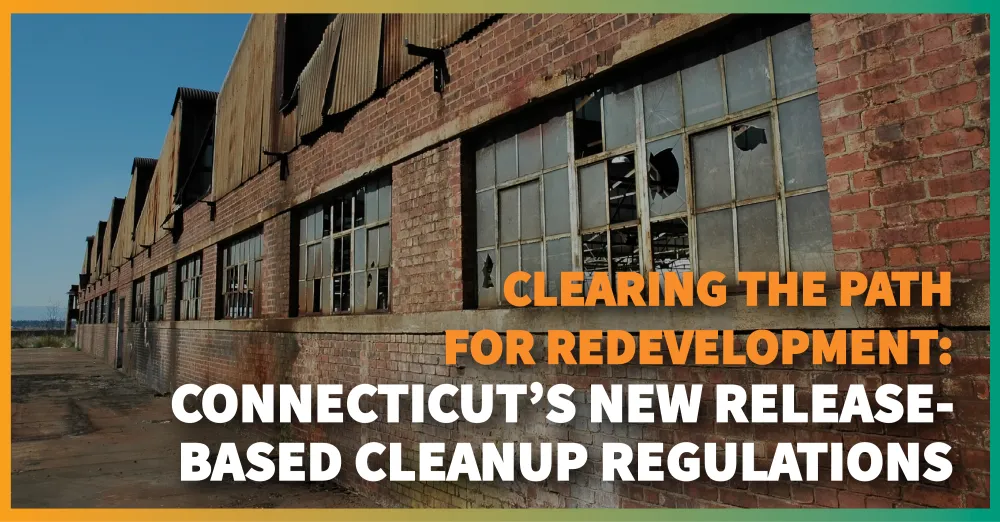Clearing the Path for Redevelopment: Connecticut’s New Release-Based Cleanup Regulations
October 13th, 2025

“Too complex and burdensome, not fair to everyone, and too costly.”
That’s how Jason Beach, Principal and Regional Manager at HRP Associates, sums up Connecticut’s old Connecticut Property Transfer Act—or Transfer Act, as it’s commonly called. Enacted in 1985, the Transfer Act was designed to protect buyers from inheriting contaminated properties and ensure responsible parties cleaned up any associated environmental hazards. But decades later, its limitations had become clear.
The Transfer Act applied to the transfer of "establishments,” defined as properties or businesses where hazardous waste was generated or where certain hazardous waste-related activities took place, such as a dry cleaning operation, an auto body repair facility, a furniture stripping facility, or properties or businesses that generated more than 100 kilograms of hazardous waste in a one month period.
Under the Act, an investigation of a parcel of land that was being transferred – whether it’s the land or the business that operated on the land – was required. The buyer and seller had to negotiate who would be responsible for certifying to Connecticut DEEP that they would agree to investigate and remediate any releases on that parcel or at that business within a certain timeframe to meet the cleanup standards known as the “remediation standard regulations.”
“The Transfer Act wasn’t redevelopment friendly. It got in the way of deals ultimately limiting cleanup of a lot of environmentally distressed properties,” says Jason. “Driving through many of the cities throughout Connecticut, you see closed-down factories just sitting there. Part of that was the Transfer Act issue.”
Enter the Release-Based Cleanup Regulations (RBCRs), which were adopted in May 2025 and will go into effect March 1, 2026. These new rules are designed to clear a path for property redevelopment while protecting public health and the environment.
“The big difference between the new regulations versus the Transfer Act is these new regulations are more of a risk-based approach to environmental matters,” Jason explains. “Rather than being driven by the ownership transaction of a business or property, it’s now about whether there is actually a known release of hazardous substances or petroleum.”
Under the old law, even a small, 0.1-acre dry cleaner could be frozen in place because selling the property triggered expensive investigations, even if ultimately no contamination had occurred. The RBCRs remove that presumption of contamination and standardize cleanup expectations across all sites—whether it’s a new “emergent” spill, an existing “historic” release, or a significant existing release.
For HRP Associates and its clients, the change means a period of learning, planning, and adaptation.
“It requires us to learn a lot between now and March 1, 2026,” Jason says. “We’re busy reading, re-reading, and re-reading again. How do these regulations impact what we do? How do they impact our clients? There’s a bit of a learning curve for everyone.”
Part of that learning curve involves new players in the cleanup process, including Permitted Environmental Professionals (PEPs)—individuals permitted by the State who can oversee cleanup efforts for certain lower-risk releases, allowing HRP to focus resources where they’re needed most.
Despite the challenge, Jason sees promise in the new framework.
“I think good things will come out of this. The regulations are risk-based, practical, and better aligned. They allow us to deal with issues as they actually exist rather than guessing whether an issue might exist. That means faster, smarter cleanups and, ultimately, more properties available for redevelopment.”
HRP is already gearing up, conducting internal workshops, talking with clients, and producing educational content to help everyone navigate the transition. “We’re figuring out how we can best consult our clients on these new regulations,” says Jason. “It’s about taking what could be a complex, confusing change and turning it into an opportunity to do things better.”
Connecticut’s brownfields and other environmentally distressed properties have waited long enough. With the RBCRs, a new chapter of redevelopment, risk-based regulation, and practical solutions is on the horizon, and HRP Associates is ready to lead the way.







